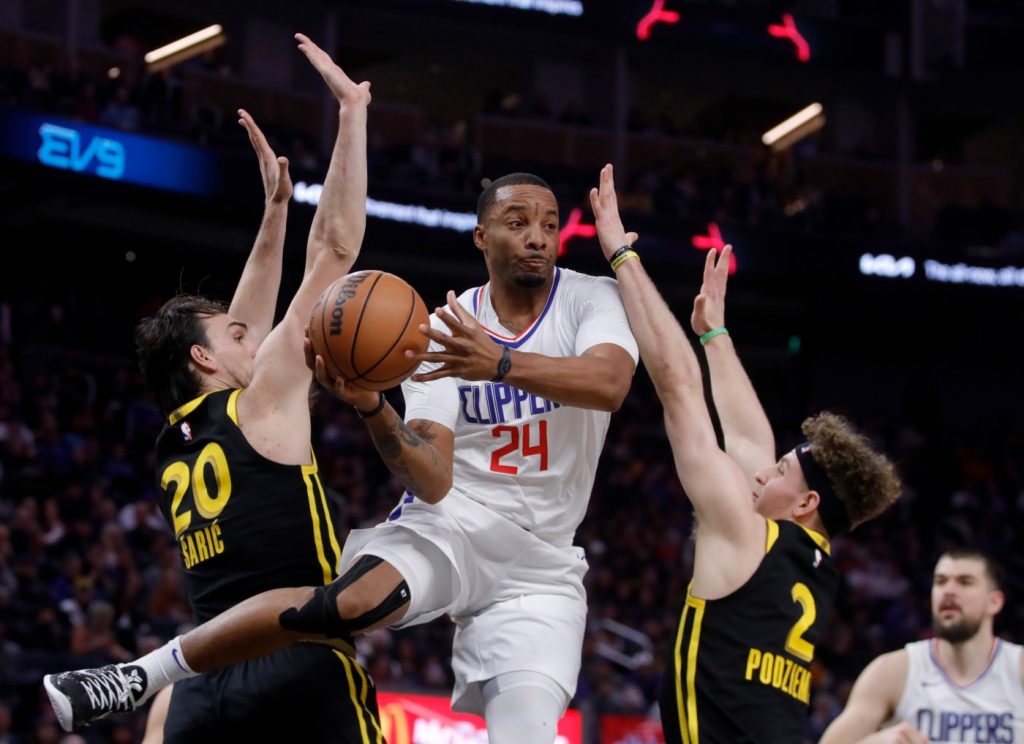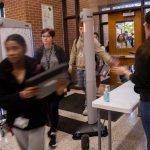An opus palladianum, or crazy paving, is a type of mosaic defined by irregularity. The artist would take scraps of oddly shaped stone and glass, mold and bind it to mortar, and call it an abstract work of art.
The mural outside of Chase Center is a beautiful example of this style. It’s impossible to ignore how these jagged, colorful pieces of glass of different proportions are bonded to form a portrait of children vying for a basketball amid landmarks that represent the Bay Area.
The artists taking up a 41-day exhibit inside the arena are trying to emulate the same effect with mixed and irregular results.
The Golden State Warriors are 10th in the Western Conference at 27-26 at the season’s halfway mark. For every piece of regularity for this team, there’s irregularity nearby. It’s mostly noticeable in the Warriors’ struggles in late-game execution.
Golden State is 18-19 in 37 clutch games (within five points in the last five minutes) despite Stephen Curry leading the NBA in clutch-time points (165), field goal percentage (50.5), and 3-point field goal percentage (47.5). His brilliance late in fourth quarters has been mitigated by defensive collapses.
In clutch minutes, the Warriors are 26th in the league in defensive rating at 120.4 and opponents’ effective field goal percentage at 55.8%. Failure to close games defensively and blowing leads have contributed to Golden State treading water during the first half of the season.
Conversely, stronger defense is one of the main reasons why the Warriors are 8-2 in their last 10 games before the All-Star break. During this stretch, they have a 111.2 defensive rating. Here are some positive and negative trends on defense that are creating the mosaic of the Warriors’ season at the midway point.
Overhelping
The Warriors gave up 44 points in the fourth quarter en route to a 125-130 loss to the Los Angeles Clippers on Feb. 14. Against the Utah Jazz the next night, they surrendered 35 in a 140-137 win. These games, like many this season, illustrate the Warriors’ inconsistencies on defense. Their biggest flaw is the habit of overhelping when it isn’t necessary.
In some cases, overhelping is by necessity due to a team’s advantages or disadvantages. For the Warriors, their disadvantage is the lack of size and versatility defensively. It’s not unusual for them to require help to prevent penetration, for example, or help to defend the roller in pick-and-roll situations, like this play early in the fourth quarter against the Clippers.
Brandin Podziemski, for all of his hustle and tenacity, can’t effectively guard James Harden alone. Draymond Green pulls up in a soft trap before recovering to Ivica Zubac. In Green’s recovery, Moses Moody comes from the weak side to help Green, which leaves Russell Westbrook open for an easy layup on a backcut.
This overhelp was necessary at the beginning of the play with Green. It became unnecessary, however when Moody came over to double Zubac. Had Moody stayed on Westbrook, Green could have tried to contest Zubac’s shot. At best, the Warriors would have gotten a stop and an opportunity to score in transition. At worst, Zubac, a 65.3% free-throw shooter would have to earn it at the line.
The Warriors’ tendency to overhelp harms them when it comes to closing out on shooters because of the need to protect and crowd the paint.
Notice the action on the strong side. Jazz guard Kris Dunn drives by Andrew Wiggins. Trayce Jackson-Davis leaves Walker Kessler to stop Dunn’s drive. In the process, Podziemski are trying to help the helper while leaving Talen Horton-Tucker open for three.
Losing the war of attrition
It’s no secret that the Warriors are an old team. As an old team, they tend to fade in the second half, and when they try to keep up with a fast-paced team. They also fade while defending since it takes more effort than running an offense.
In addition to their age, the Warriors are small, which creates more potential mismatches for opposing offenses to exploit. Opposing teams with a size advantage can either attack the paint or drive and kick to open shooters, knowing that the Warriors have a tendency to overhelp. That cycle has contributed to some of the late-game collapses.
The Warriors also haven’t been fully healthy. Guards Chris Paul, Gary Payton II, and Moses Moody all missed time during the first half of the season. Green’s well-documented 16-game suspension also compromised their defense. Which leads me to one of the main reasons why the Warriors are 8-2 in their last 10 games.
The Draymond effect
Since returning to the lineup and to playing center, Green’s impact on defense has been huge heading into the second half of the season.
The former starting lineup of Curry, Klay Thompson, Green, Andrew Wiggins and Jonathan Kuminga has a defensive rating of 99.0 in 132 minutes on the floor. The current starting lineup of Curry, Green, Wiggins, Kuminga, and Podziemski have a defensive rating of 102.6 in their 107 minutes of action.
Green’s immediate impact on defense is obvious. He’s as disruptive to opposing defenses as he has ever been. To me, however, his ability to communicate to others on the floor stands out. It’s him directing and guiding Wiggins, Kuminga, Podziemski and others, making sure the defense is connected.
Wiggins trending upward
Wiggins spent most of the season in a slump on both ends of the floor. While the lack of production on offense was concerning, the lack of aggression and awareness on defense hurt the team the most.
However, Wiggins has been surging in recent games. He’s been more disruptive defensively at the point of attack. His best defensive effort in months came against the Indiana Pacers on Feb. 8 when he contributed to holding All-Star Tyrese Halliburton to five points. More performances close to this effort defensively from Wiggins and the Warriors have a chance to finish the season strong.
The Warriors’ season has been a mosaic. They’ve been trying to make irregular lineups, and skillsets work with regularity. Whether or not this season turns out to be a solid work of art depends on the defense that binds them.


